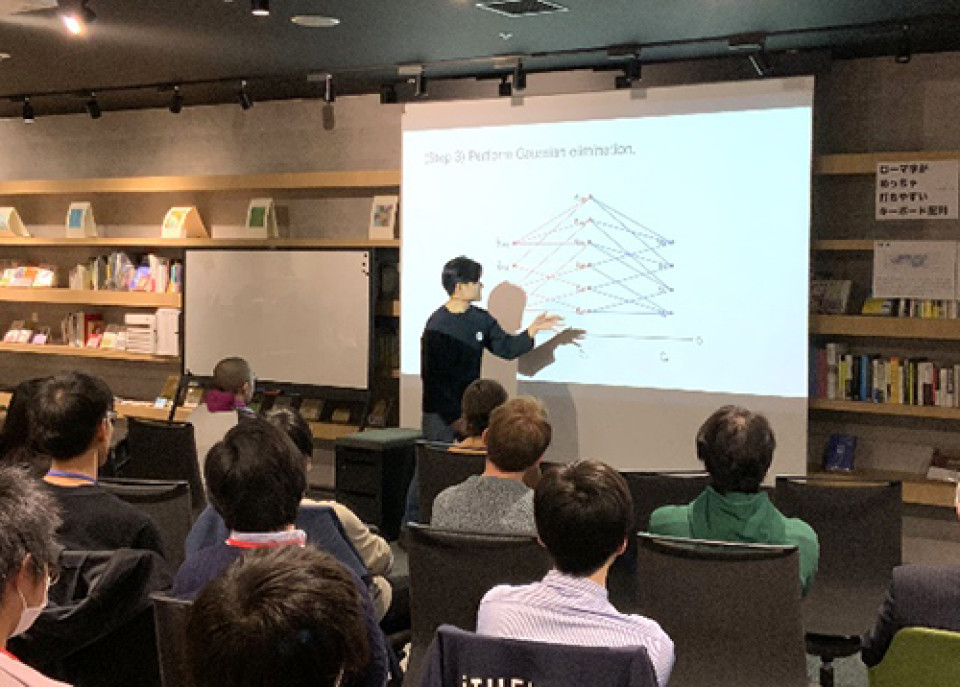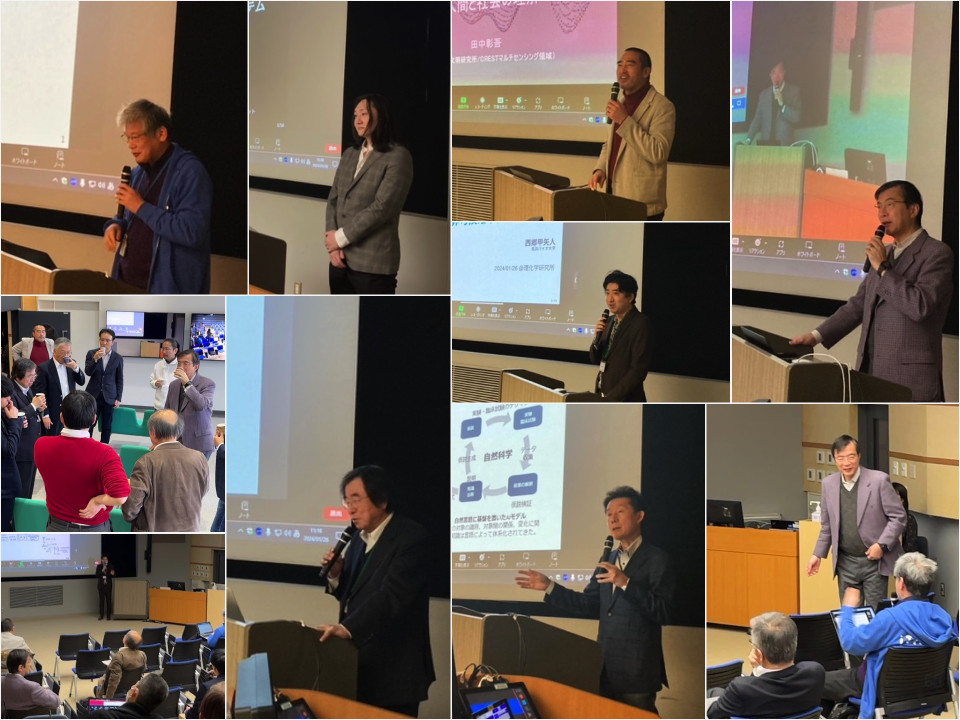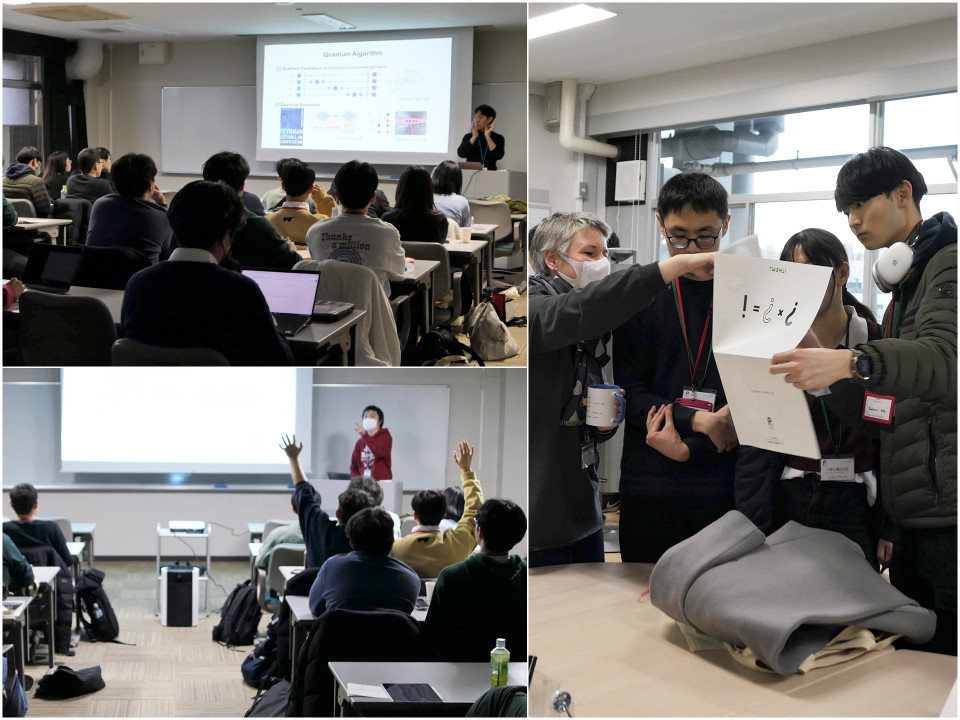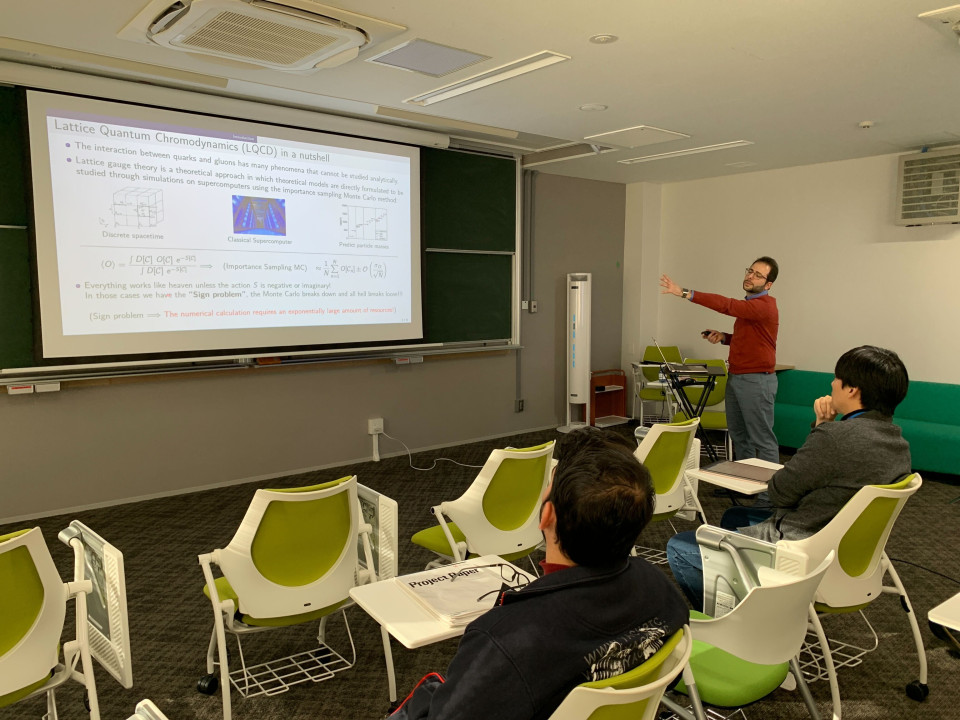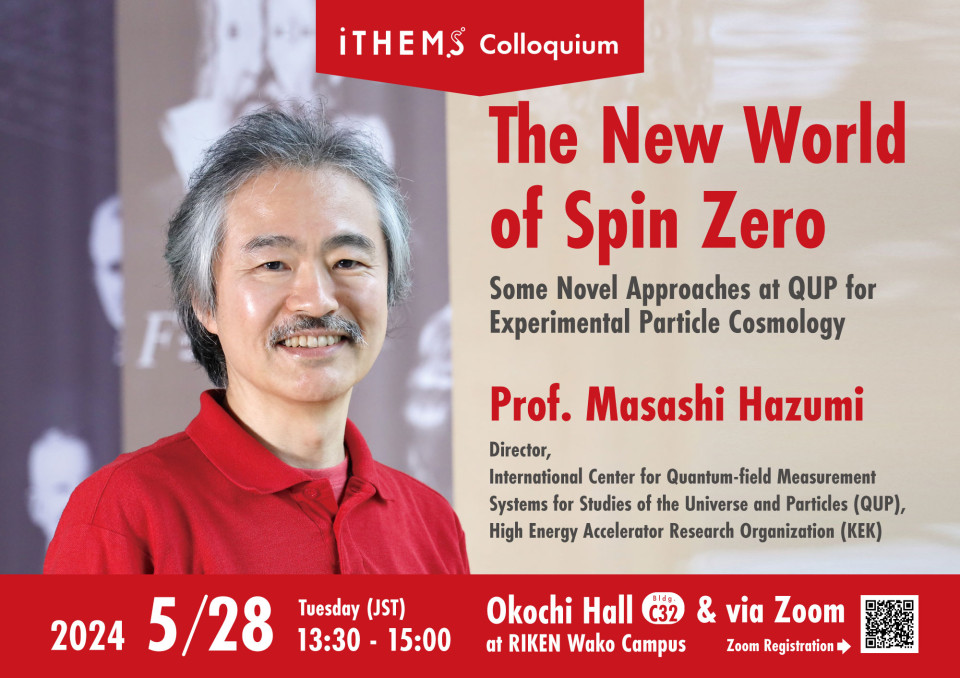Volume 288
Back to Newsletter List
Hot Topic
iTHEMS held exchange event with members of the Masason Foundation
2024-01-30
RIKEN Interdisciplinary Theoretical and Mathematical Sciences Program (iTHEMS) held its first exchange event with members of the Masason Foundation on Thursday, December 7th, 2023, as part of its efforts to nurture young talent for the future. Thirteen Foundation members, ranging in age from 9 to 26 years old, with interests in mathematics, physics, biology, AI, etc., and ten iTHEMS researchers participated in the event, engaging in high-level discussions and stimulating exchanges.
For more details, please see the main text below.
Hot Topic
“Quantum-like Modeling” in Biology, Cognitive & Social Sciences on January 26, 2024
2024-01-30
A workshop titled "Quantum-like modeling in biology, cognitive & social sciences", jointly organized by iTHEMS, RIKEN Quantum, and JST-CREST "Multi-sensing" area, was held on Jan. 26 (Fri), 2024 from 9:30 to 17:00 in Okochi Memorial Hall and Zoom.
At the beginning of the workshop, Atsushi Iriki (RIKEN), research supervisor of JST-CREST "Multi-sensing" area, explained the purpose of the workshop, followed by Tetsuo Hatsuda (RIKEN) introducing the several quantum computers available in RIKEN Quantum. After that, Hayato Saigo (Nagahama Institute of Bio-Science and Technology) gave a talk on "Overview of open quantum systems focusing on JST-CREST projects", and there was a discussion on the possibilities and expectations for modeling and interpretation of general phenomena using quantum theoretical mathematics. Then, Masanao Ozawa (Chubu Univ.) gave a talk on "Theory of non-commutative ordering effects and new mathematical theory in breakthroughs", and there was a discussion on the design of complementary collaboration between experimentalists and mathematicians, and the creation of "new mathematics”.
After a lunch break, Takuya Isomura (RIKEN) gave a talk on "Path integral methods in Bayesian inference variational free energy principle", and there was a discussion on the quantum interpretation in biochemistry, neuroscience, cognitive science, and psychiatry. Following this, Shogo Tanaka (Tokai Univ.) gave a talk on "From an atomistic view of humanity to understanding human beings and society through quantum metaphors", and there was a discussion on the possibilities of social implementation of quantum phenomena and quantum computations in the humanities and social sciences. Finally, there was a general discussion on “quantum-like modeling” and the path integral/quantum interpretation of the evolution/history of "human phenomena".
About 70 participants, both onsite and online, had an enthusiastic discussion on the quantum interpretation of various phenomena in the humanities and social sciences, and on the possibilities of quantum computation.
“Quantum-like Modeling” in Biology, Cognitive & Social Sciences
January 26 (Fri) 9:30 - 17:00, 2024
Hot Topic
Seoul National University student group visited iTHEMS on January 10, 2024
2024-01-26
On Wednesday, January 10, a group of 22 undergraduate students part of a student group called GLEAP from Seoul National University (SNU) came to visit iTHEMS, accompanied by Professor Ji-Young Lee, Associate Dean of the College of Natural Sciences in the School of Biological Sciences at SNU. The students were from various years (2nd to 4th year undergraduates) and a wide range of scientific fields, including mathematics, chemistry, biology, physics, and statistics. Their visit to iTHEMS was part of a several days' tour of various Japanese universities and research institutes, to consider their future career opportunities and research directions.
Upon arriving at RIKEN, the group was greeted by iTHEMS members Dongwook Ghim and Catherine Beauchemin, and were first taken on a tour of the Nishina Center ion beam accelerators. They then enjoyed very brief, casual conversation in the iTHEMS common rooms with some snacks. Catherine Beauchemin gave a 5-min introduction of the various opportunities for SNU students to become iTHEMS members in the future (e.g., JRA, IPA, SPDR, RS/SRS). Then 6 different iTHEMS researchers (Dongwook Ghim, Misako Tatsuuma, Akinori Tanaka, Catherine Beauchemin, Steffen Backes, Ryo Namba) gave great 12 min talks about their research, and some additional iTHEMS members also joined. After that, several additional iTHEMS members joined and each of the students and iTHEMS members briefly introduced themselves and their research interests. This was followed by interesting, casual discussions between iTHEMS members and the SNU students over light food. The students told me they thoroughly enjoyed their visit to iTHEMS and learning about the wide range of research our members conduct. Overall, this provided a great opportunity to showcase iTHEMS members' research to young researchers considering their future academic career.
Many thanks for the amazing support provided by all the iTHEMS assistants without whom this event would not have been possible, to the iTHEMS researchers who took their time to take part in this event and make it so interesting for the students, and with special thanks to Dongwook Ghim, himself is a graduate of SNU, for all his help and for being such an inspiring role model for these students of his alma mater.
Reported by Catherine Beauchemin
Seoul National University student group visit
January 10 (Wed) 14:00 - 20:00, 2024
Seminar Report
Quantum Computation SG Seminar by Emanuele Mendicelli on December 18, 2023
2024-01-30
Dr. Emanuele Mendicelli presented his work on the study a SU(2) pure gauge lattice theory on a quantum annealer by D-Wave.
Reported by Enrico Rinaldi
Energy spectrum and time evolution of a SU(2) pure gauge lattice theory on a quantum annealer
December 18 (Mon) 14:00 - 15:00, 2023
Upcoming Events
Conference
Co-hosted by iTHEMS
Can social issues be solved by mathematical science!? - Mathematical Research in Corporations
February 3 (Sat) 13:00 - 17:00, 2024
Continuing from the previous fiscal year, we will be hosting a symposium exploring the potential of solving societal issues through mathematical science research. In the past two years, the themes were "Attempts and Challenges" and "Connecting Corporate Issues and Mathematical Sciences." This year, we will focus on concrete examples under the title "Mathematical Research in Corporations" with the aim of introducing activities utilizing mathematics in the corporate sector.
Currently, we are inviting speakers with diverse backgrounds, including researchers actively engaged in mathematical activities within corporations or those who have transitioned from corporate mathematical research to academic settings. We are particularly interested in learning about the experiences of individuals who have used mathematics in corporate settings.
Additionally, there has been a growing trend in connecting activities of graduate students in mathematics with corporate endeavors. By sharing such initiatives with participants, we plan to conduct a panel session for exchanging opinions on the role of mathematical science in addressing societal issues through corporate collaboration in the future.
We sincerely look forward to the active participation of corporate researchers and mathematicians who have an interest in these activities.
Venue: Hybrid Format (Noyori Conference Hall, Nagoya University and Zoom)
Event Official Language: Japanese
Seminar
iTHEMS Theoretical Physics Seminar
Nuclear Energy-Density Functional Approach to Bridging Neutron-Rich Nuclei and Neutron Stars
February 5 (Mon) 13:30 - 15:00, 2024
Kenichi Yoshida (Associate Professor, Research Center for Nuclear Physics, Osaka University)
Understanding the properties of neutron-rich nuclei has been a central subject in low-energy nuclear physics. The great interest lies not only in the pursuit of a variety of structures and the elucidation of the mechanisms of their occurrence but also in obtaining insights into the structure of the inner crust of neutron stars. With advances in neutron-star observation techniques, the structure of neutron stars has been becoming better understood. The data accumulated from these observations unveil properties of neutron-rich matter that are otherwise inaccessible through terrestrial experiments.
In this talk, I will introduce an attempt to construct a nuclear energy-density functional (EDF) inspired by the observations and then demonstrate its applicability to nuclear structure problems, including mass and deformation. One intriguing aspect of neutron stars is the emergence of superfluidity, especially the occurrence of spin-triplet pairing. I will discuss the unconventional pairing in nuclei within the nuclear EDF framework and give perspectives on the study of the phase diagram of the superfluidity in neutron stars.
This seminar is co-hosted by UKAKUREN.
Venue: Seminar Room #359, 3F Main Research Building, RIKEN / via Zoom
Event Official Language: English
Seminar
iTHEMS Theoretical Physics Seminar
Recent advances in nuclear Density Functional Theory and applications to the nuclear response
February 6 (Tue) 13:30 - 15:00, 2024
Gianluca Colò (Professor, Department of Physics, University of Milan, Italy / Professor, Sezione di Milano, INFN, Italy)
In this contribution, I will give an overall (and, of course, biased) view of the general status of DFT. I will stress that, in contrast to ab initio methods, DFT is the only framework that allows the study of excited states, including those lying at relatively high energy. Accordingly, I will focus on the nuclear response.
After a reminder on the nuclear Giant Resonances and the link with the nuclear equation of state, I will discuss the projection methods to restore symmetries in the calculations of deformed systems. While symmetry-restored calculations are nowadays of common use in the study of ground-state properties and low-lying excitations, similar realistic investigations for the nuclear response are essentially missing in the literature. Recently, we have implemented an exact Angular Momentum Projection (AMP) on top of Skyrme-Random Phase Approximation (RPA) calculations in a projection after variation (PAV) scheme, for the first time. The results will be critically analysed in the case of the monopole response, also taking into account the experimental investigations that can be envisioned for well-deformed systems.
If time allows, the nuclear response will be also discussed as a way to improve the current density functionals and ground them on ab initio nuclear theory.
This seminar is co-hosted by Nuclear Many-body Theory Laboratory and Few-body Systems in Physics Laboratory, RIKEN Nishina Center for Accelerator-Based Science.
Venue: 2F Large Meeting Room, RIBF Building, RIKEN Wako Campus / via Zoom
Event Official Language: English
Seminar
ABBL-iTHEMS Joint Astro Seminar
Relativistic Jet Simulations and Modeling on Horizon Scale
February 8 (Thu) 13:00 - 14:30, 2024
Yosuke Mizuno (T.D. Lee Fellow / Associate Professor, Tsung-Dao Lee Institute, Shanghai Jiao Tong University, China)
Relativistic jets are launched in the vicinity of the central black holes and emit powerful radiation across the electromagnetic spectrum. According to our current understanding, relativistic jets are launched by directly tapping the rotational energy of spinning black holes via
the so-called Blandford-Znajek process. In addition to the spin of the black hole, numerical simulations showed the amount of accreted magnetized flux has a major impact on the formation of relativistic jets. We have investigated the radiative signatures of self-consistently launched relativistic jets using 3D general relativistic magneto-hydrodynamical simulations and general relativistic radiative transfer calculations in horizon scale to the connection with large-scale structure. We discuss our findings and comparison with observations.
Venue: Seminar Room #359, 3F Main Research Building, RIKEN / via Zoom
Event Official Language: English
Seminar
iTHEMS Biology Seminar
Chemical reaction network theory and the problem of reaction rate
February 8 (Thu) 16:00 - 17:00, 2024
Tomoharu Suda (Postdoctoral Researcher, Biofunctional Catalyst Research Team, RIKEN Center for Sustainable Resource Science (CSRS))
A chemical system can be described at different levels. When we focus on the population of chemical species, it is convenient to consider the system as consisting of a number of chemical reactions, which assumes the structure of a (hyper)graph together with the species. The chemical reaction network theory studies chemical systems described in such a way. It aims to elucidate the dynamics of overall chemical composition in terms of the associated graph structure. Notably, it applies not only to chemical systems but also to more general systems as long as the mathematical structure is compatible. In the first part of this talk, we will review the basic concepts and results of the theory, which mainly concern the existence and stability of the equilibrium. From the viewpoint of chemical kinetics, it is interesting to consider the rate of the overall reaction, which may be obtained by the total balance of chemical species. The second part of the talk will be devoted to this topic. Formulation of the problem and some results will be presented. In particular, chemical reaction networks with first-order reactions will be considered in detail.
Venue: Hybrid Format (3F #359 and Zoom), Main Research Building, RIKEN Wako Campus
Event Official Language: English
Seminar
iTHEMS Biology Seminar
Cellular-level left-right asymmetry, cell chirality, induces the chiral collective rotation of multicellular colony
February 15 (Thu) 16:00 - 17:00, 2024
Tomoki Ishibashi (Special Postdoctoral Researcher, Laboratory for Physical Biology, RIKEN Center for Biosystems Dynamics Research (BDR))
Ryohei Nishizawa (Ph.D. Student, Graduate School of Frontier Biosciences, Osaka University)
The left-right (LR) asymmetric morphology of organs is essential for the development and maintenance of their functions in various species. In recent years, it has become clear that the LR asymmetry of organs originates from cell chirality, the LR asymmetric nature at the cellular level [1]. However, it is unclear how the cell chirality generates the LR asymmetry at the multicellular level. Here we show a mechanism of LR asymmetry formation at the multicellular level based on cell chirality. We previously found that Caco-2 cells, a typical cultured epithelial cell line derived from human colon cancer, exhibit stereotypical and directional cell chirality; when Caco-2 cells are cultured as single cells, their nuclei and cytoplasm rotate in the clockwise direction at a rate of 50°/h [2]. Interestingly, when Caco-2 forms multicellular colonies, the colonies also undergo a collective clockwise rotation at 10º/h. We revealed that the actomyosin cytoskeleton is essential for the formation of the collective rotation [2]. We also found that Caco-2 cells formed lamellipodia and focal adhesions LR asymmetrically during the collective colony rotation, which may be responsible for the chiral collective motion. Interestingly, the disruption of microtubules reversed the direction of collective rotation. The LR asymmetric formation of lamellipodia and focal adhesions was also reversed by inhibition of microtubule polymerization. We will discuss the possible mechanism and the mathematical model where cell chirality induces multicellular chiral rotation depending on microtubules.
References
- Utsunomiya, S., Sakamura, S., Sasamura, T., Ishibashi, T., Maeda, C., Inaki, M., Matsuno, K., "Cells with Broken Left–Right Symmetry: Roles of Intrinsic Cell Chirality in Left–Right Asymmetric Epithelial Morphogenesis", Symmetry 11(4), 505 (2019), doi: 10.3390/sym11040505
- Yamamoto, T., Ishibashi, T., Kiyosue-Mimori, Y., Hiver, S., Tokushige, N., Tarama, M., Takeichi, M., Shibata, T., "Epithelial cell chirality emerges through the dynamic concentric pattern of actomyosin", bioRxiv 2023.08.16.553476, doi: 10.1101/2023.08.16.553476
Venue: Seminar Room #359, 3F Main Research Building, RIKEN / via Zoom
Event Official Language: English
Workshop
Second Workshop on Fundamentals in Density Functional Theory (DFT2024)
February 20 (Tue) - 22 (Thu) 2024
The density functional theory (DFT) is one of the powerful methods to solve quantum many-body problems, which, in principle, gives the exact energy and density of the ground state. The accuracy of DFT is, in practice, determined by the accuracy of an energy density functional (EDF) since the exact EDF is still unknown. Currently, DFT has been used in many communities, including nuclear physics, quantum chemistry, and condensed matter physics, while the fundamental study of DFT, such as the first principle derivations of an accurate EDF and methods to calculate many observables from obtained densities and excited states. However, there has been little opportunity to have interdisciplinary communication.
On December 2022, we had the first workshop on this series (DFT2022) at Yukawa Institute for Theoretical Physics, Kyoto University, and several interdisiplinary discussions and collaborationd were started. To share such progresses and extend collaborations, we organize the second workshop. In this workshop, the current status and issues of each discipline will be shared towards solving these problems by meeting together among researchers in mathematics, nuclear physics, quantum chemistry, and condensed matter physics.
This workshop mainly comprises lectures/seminars on cutting-edge topics and discussion, while a half-day session composed of contributed talks is also planned.
This workshop is partially supported by iTHEMS-phys Study Group. This workshop is a part of the RIKEN Symposium Series.
The detailed information can be found in the workshop website.
Venue: 8F, Integrated Innovation Building (IIB), Kobe Campus, RIKEN / via Zoom
Event Official Language: English
Colloquium
iTHEMS Colloquium
The New World of Spin Zero - Some Novel Approaches at QUP for Experimental Particle Cosmology -
May 28 (Tue) 13:30 - 15:00, 2024
Masashi Hazumi (Director, Professor, International Center for Quantum-field Measurement Systems for Studies of the Universe and Particles (QUP), High Energy Accelerator Research Organization (KEK))
Particle cosmology is a discipline seeking a fundamental understanding of the Universe based on particle physics. Five mysteries drive our research today: cosmic inflation, baryon asymmetry, neutrino properties, dark matter, and dark energy.
Resolving any of the five mysteries will revolutionize our picture of the Universe. Numerous interesting theoretical hypotheses have been proposed to this end. Many require new scalar quantum fields, such as inflatons, axions, supersymmetric particles, etc. They are, in a sense, an attempt to expand the role of the vacuum. Since we have not found such spin-zero fields yet, we shall invent new eyes to make an experimental or observational breakthrough.
The International Center for Quantum-field Measurement Systems for Studies of the Universe and Particles (QUP) was established in December 2021 at KEK under the WPI program of MEXT and JSPS. With its tagline of "bring new eyes to humanity," one of the primary missions of QUP is inventing and developing such new eyes for particle cosmology. In this seminar, after briefly introducing QUP, I focus on research topics I have contributed, including the LiteBIRD satellite to study inflatons and light scalar quantum field searches with novel methods using quantum sensing techniques.
Venue: Okochi Hall, 1F Laser Science Laboratory, RIKEN / via Zoom
Event Official Language: English
Seminar
ABBL-iTHEMS Joint Astro Seminar
Do plants have bones? Silica phytoliths and their role and fate in the development of terrestrial plants and human civilizations
March 1 (Fri) 14:00 - 15:15, 2024
Mikhail Blinnikov (Professor, St. Cloud State University, USA)
Silicon is the second most common element in the Earth’s crust. Some families of higher plants evolved mechanisms for soluble silica to be carried by xylem from groundwater and deposited as plant opal in or around plant cells as phytoliths thought to play a role in the structural support and defense against herbivores. While known since the early 19th century, phytoliths remain an intriguing class of microfossils whose formation and role in plants and their preservation in soils and sediments are a subject for a lot of active research. I outline some emerging themes in phytolith analysis including phytoliths’ role in global biogeochemical cycles, plant-herbivore interactions, and their tracing of evolution of cultural plants, especially cereals such as rice (Oryza), wild rice (Zizania), maize (Zea), wheat (Triticum) and millet (Panicum), all relevant to global archaeology. Some emerging research on phytoliths connects their changes in shapes to plant taxonomy of some families such as grasses and opens up avenues for further investigation of their active construction in the cells of some taxa by yet undiscovered genetically mediated mechanisms. New image analysis techniques and some advanced microscopy methods will allow us to further the field of phytolith study using deep machine learning algorithms and true 3D analysis of their shapes, something where contribution from other branches of science are most welcome.
Venue: Seminar Room #359, 3F Main Research Building, RIKEN / via Zoom
Event Official Language: English
Paper of the Week
Week 1, February 2024
2024-02-01
Title: Search for heavy dark matter from dwarf spheroidal galaxies: leveraging cascades and subhalo models
Author: Deheng Song, Nagisa Hiroshima, Kohta Murase
arXiv: http://arxiv.org/abs/2401.15606v1
Title: Acceleration and transport of relativistic electrons in the jets of the microquasar SS 433
Author: H.E.S.S. Collaboration (Naomi Tsuji)
Journal Reference: Science383,402-406(2024)
doi: https://doi.org/10.1126/science.adi2048
arXiv: http://arxiv.org/abs/2401.16019v1
Title: Interparticle normal force in highly porous granular matter during compression
Author: Sota Arakawa, Misako Tatsuuma, Hidekazu Tanaka, Mikito Furuichi, Daisuke Nishiura
arXiv: http://arxiv.org/abs/2401.14990v1
Title: The metamorphosis of the Type Ib SN 2019yvr: late-time interaction
Author: Lucía Ferrari, Gastón Folatelli, Hanindyo Kuncarayakti, Maximilian Stritzinger, Keiichi Maeda, Melina Bersten, Lili M. Román Aguilar, M. Manuela Sáez, Luc Dessart, Peter Lundqvist, Paolo Mazzali, Takashi Nagao, Chris Ashall, Subhash Bose, Seán J. Brennan, Yongzhi Cai, Rasmus Handberg, Simon Holmbo, Emir Karamehmetoglu, Andrea Pastorello, Andrea Reguitti, Joseph Anderson, Ting-Wan Chen, Lluís Galbany, Mariusz Gromadzki, Claudia P. Gutiérrez, Cosimo Inserra, Erkki Kankare, Tomás E. Müller Bravo, Seppo Mattila, Matt Nicholl, Giuliano Pignata, Jesper Sollerman, Shubham Srivastav, David R. Young
Journal Reference: MNRAS Letters, 529, L33 (2024)
doi: https://doi.org/10.1093/mnrasl/slad195
arXiv: http://arxiv.org/abs/2401.15052v1
Title: Diagrammatic representations of 3-periodic entanglements
Author: Toky Andriamanalina, Myfanwy E. Evans, Sonia Mahmoudi
arXiv: http://arxiv.org/abs/2401.14254v1
Title: Doubly charmed tetraquark $T_{cc}^+$ in (2+1)-flavor QCD near physical point
Author: Yan Lyu, Sinya Aoki, Takumi Doi, Tetsuo Hatsuda, Yoichi Ikeda, Jie Meng
arXiv: http://arxiv.org/abs/2401.13917v1
If you would like to cancel your subscription or change your email address,
please let us know via our contact form.
Copyright © iTHEMS, RIKEN. All rights reserved.


